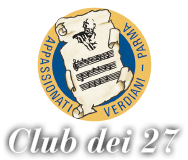This is one of the most crucial places in the Verdi biography: the home of Antonio Barezzi,a wealthy grocer, knowledgeable and enthusiastic musician, himself an expert on 5 instruments, the flute in particular. In 1816 Barezzi founded the Busseto Philharmonic Society and he perceived great musical talent in the young Verdi, so much so that he became the patron and sponsor of Verdi offering to cover all expenses for his studies. In February 1830 the first public exhibition of the young musician took place here in this house. Verdi lived here in the months which preceded his transfer to Milan to complete the musical studies financed by Barezzi, to whom the great artist would always be grateful.
Since 1979 the house has been the seat of the Associazione Amici di Verdi (the Association of Friends of Verdi) and has enjoyed a newly organised permanent exhibiton since the Verdi centenary in 2001. The new exhibition was inaugurated by the President of the Republic, Carlo Azeglio Ciampi together with Riccardo Muti. The restored salon still conserves intact the original furnishings, amongst them the Viennese Tomaschek fortepiano, bought by Barezzi in about 1835 and used by the young Verdi for many years. It was on this instrument that Verdi composed I Due Foscari (1844) and accompanied the dying breaths of his father-in-law. The house also hosts the disc collection Anthony Rocco Schipper-Suppa which contains more than 500 operas. In the adjacent rooms the immense Stefanini collection has been on display since 2001. The collection consists of Verdi memorabilia, autographed letters, portraits and iconographic documents relating to Verdi’s youth right up to his death and the Verdi Celebrations. On the external façade of the Palazzo there is a marble and bronze plaque from 1913 with an inscription written by Arrigo Boito.
